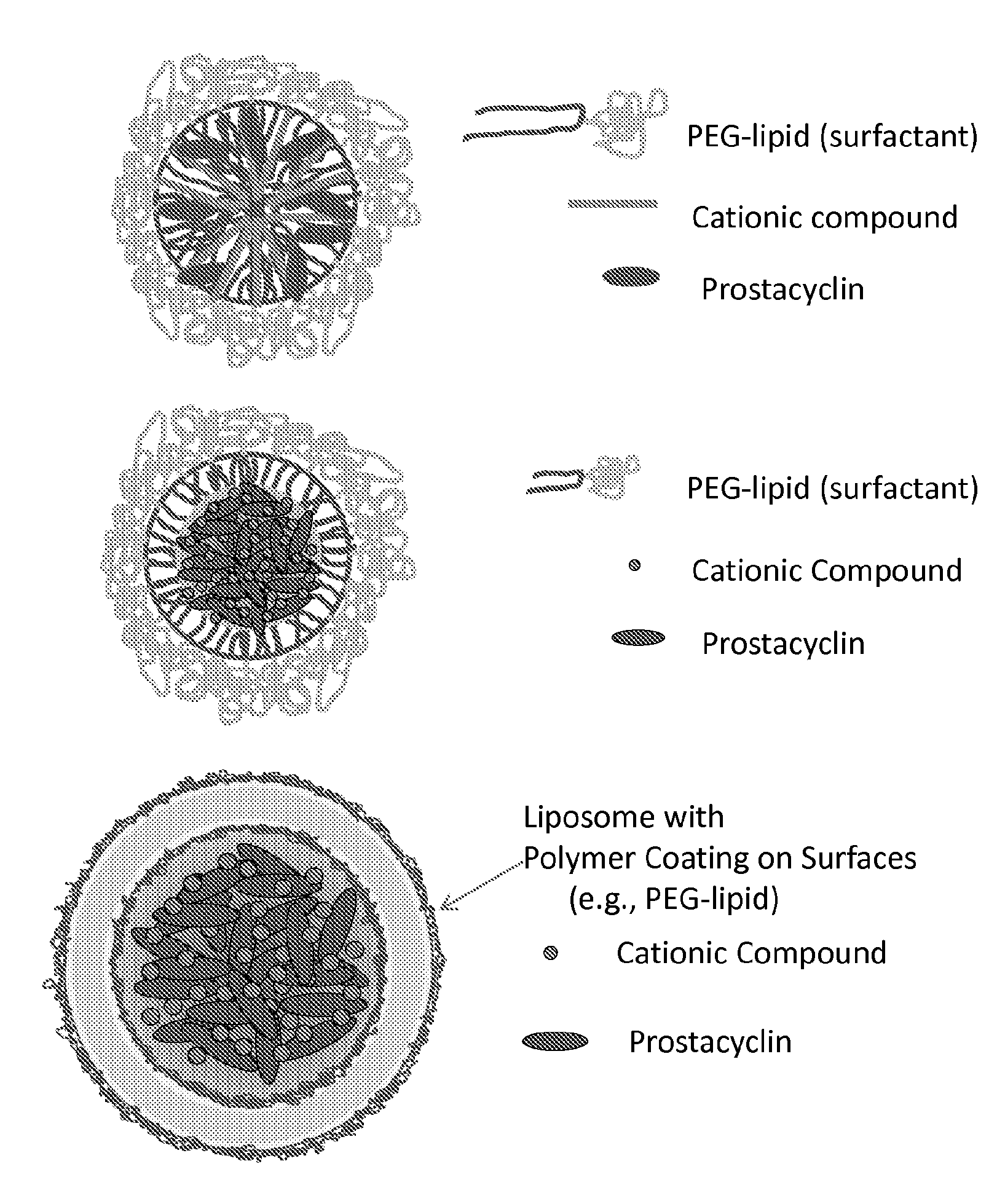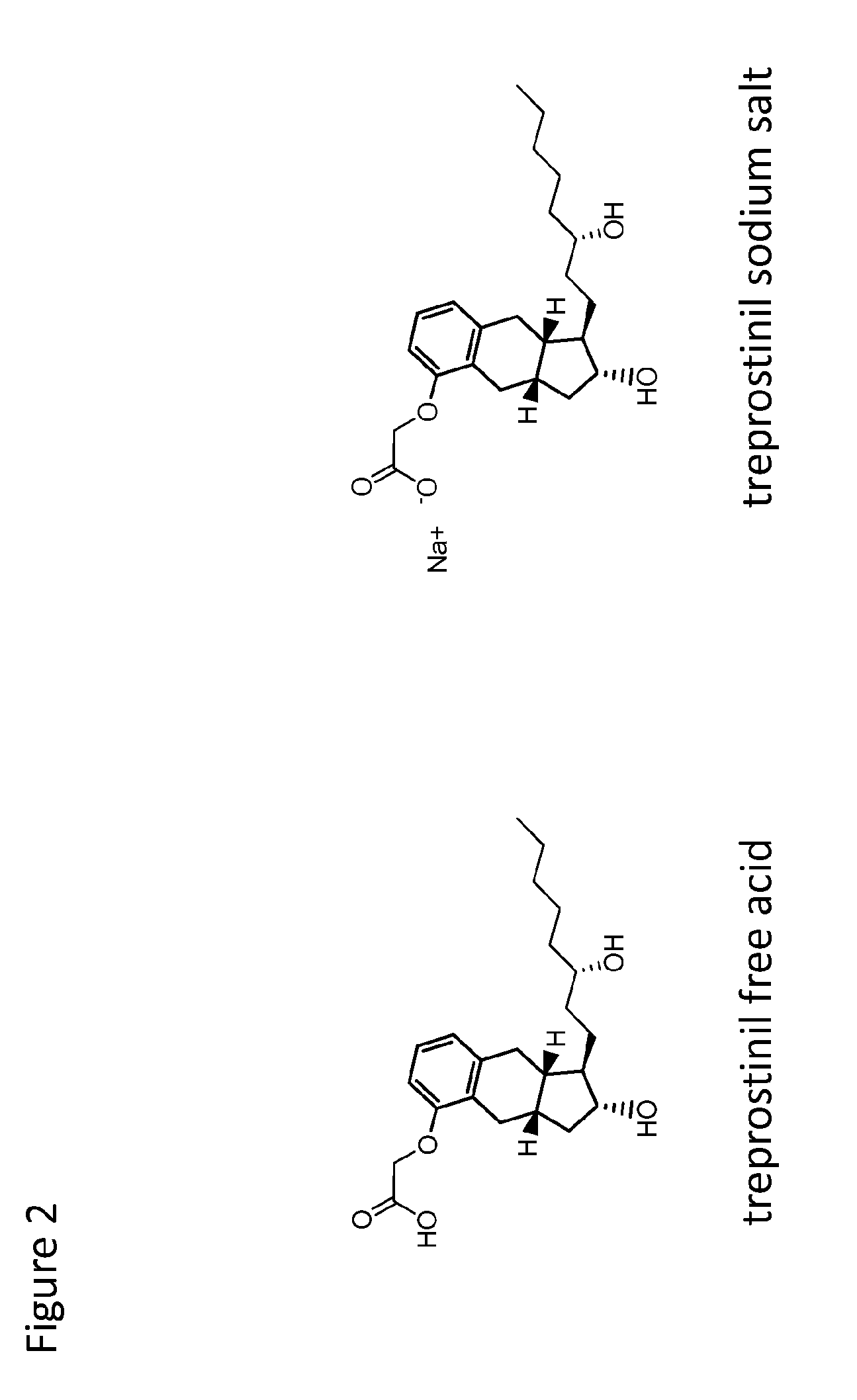Prostacylin compositions and methods for using the same
a technology of prostacylin and compositions, applied in the direction of drug compositions, dispersed delivery, cardiovascular disorders, etc., can solve the problems of limited efficacy, major problems in dosing compliance, and short half-life of treprostinil, so as to reduce systemic hemodynamic effects, reduce acute exposure to nebulization, and maximize the residence time in the lung
- Summary
- Abstract
- Description
- Claims
- Application Information
AI Technical Summary
Benefits of technology
Problems solved by technology
Method used
Image
Examples
example 1
Synthesis of Treprostinil Compositions
[0189]Treprostinil compositions of the present invention were prepared as follows. A mixture of treprostinil, cationic lipid, hydrophobic filler, and a PEGylated lipid at a desired molar ratio were dissolved in ethanol. Table 2 shows a representative number of treprostinil compositions made by the method. Additionally, the average particle size (nm) for each composition is provided at the last column.
[0190]Total concentration of components in ethanol solution was usually 40 mM or 80 mM. Certain volumes of the solution (usually 1 mL) were mixed in-line with 9 part of an aqueous buffer by combining two streams in a mixing cross with a total flow rate of 100 mL / min. The flow rate ratio of buffer (aqueous input) to lipid was approximately 20:1. See FIG. 3 for a schematic of the mixing process.
TABLE 2Representative treprostinil compositions made by the methods of Example 1.CatHydTRPTRPTRPTRPLipid (CL)AdditivePEG-lipid(moltotalFree1Free2SizeCompositio...
example 2
Particle Size Characterization of Treprostinil Compositions
[0193]All particle size measurements were performed using a Wyatt Technology Mobius™ Zeta Potential / Particle Sizing Instrument in Quasi-elastic light scattering (QELS) mode. Composition aliquots were diluted 10-fold in pre-filtered (0.02 μm pore filter) ultrapure of deionized H2O. Light scattering data were collected and converted into particle size and size distribution using Dynamics® v. 7.2.4 instrument software. Reported average particle size diameter was based on the cumulants model, which mathematically fits particle diffusion constants (determined by the raw scattering intensities of particles in a suspension) to obtain the particle size mean and a distribution of particle sizes around the mean diameter. The testing samples included T426, T420, T427, and T428. (Table 4).
TABLE 4HydrophobicCationicTRPadditivePEG-lipidcompoundComposition(mol %)(mol %)(mol %)(mol %)T420 15%SqualaneDSG-PEG2KdiC18dMA(35%)(20%)(30%)T42618.3%...
example 3
Treprostinil Nanoparticle Association as a Function of Composition Components
[0196]The effect of various composition components on the degree of treprostinil association was measured. The compositions used in the study were T590, T591 and T592 (FIG. 6A), the components of which are provided in Table 5, below. Treprostinil free % was measured as described, after diluting composition to a total treprostinil concentration of 10 μM. Treprostinil associated was calculated as 100%—TRPfree %. It was found that treprostinil association increased with increasing cationic lipid content (FIG. 6A).
TABLE 5HydrophobicCationicTRadditivePEG-lipidcompoundComposition(mol %)(mol %)(mol %)(mol %)T5905%SqualaneChol-PEG2KdiC18dMA(70%)(20%)(5%)T5915%SqualaneChol-PEG2KdiC18dMA(65%)(20%)(10%)T5925%SqualaneChol-PEG2KdiC18dMA(55%)(20%)(20%)Chol-PEG2K = cholesterol-PEG2000.diC18dMA = dioctadecyldimethyl ammonium bromide.
TABLE 6Cationic(CL) / TRPCL / TRP mo-Lipidmolar ratiolar ratio inComposition(CL)totalPEG-lipidn...
PUM
| Property | Measurement | Unit |
|---|---|---|
| mean diameter | aaaaa | aaaaa |
| pressure | aaaaa | aaaaa |
| pressure | aaaaa | aaaaa |
Abstract
Description
Claims
Application Information
 Login to View More
Login to View More - R&D
- Intellectual Property
- Life Sciences
- Materials
- Tech Scout
- Unparalleled Data Quality
- Higher Quality Content
- 60% Fewer Hallucinations
Browse by: Latest US Patents, China's latest patents, Technical Efficacy Thesaurus, Application Domain, Technology Topic, Popular Technical Reports.
© 2025 PatSnap. All rights reserved.Legal|Privacy policy|Modern Slavery Act Transparency Statement|Sitemap|About US| Contact US: help@patsnap.com



